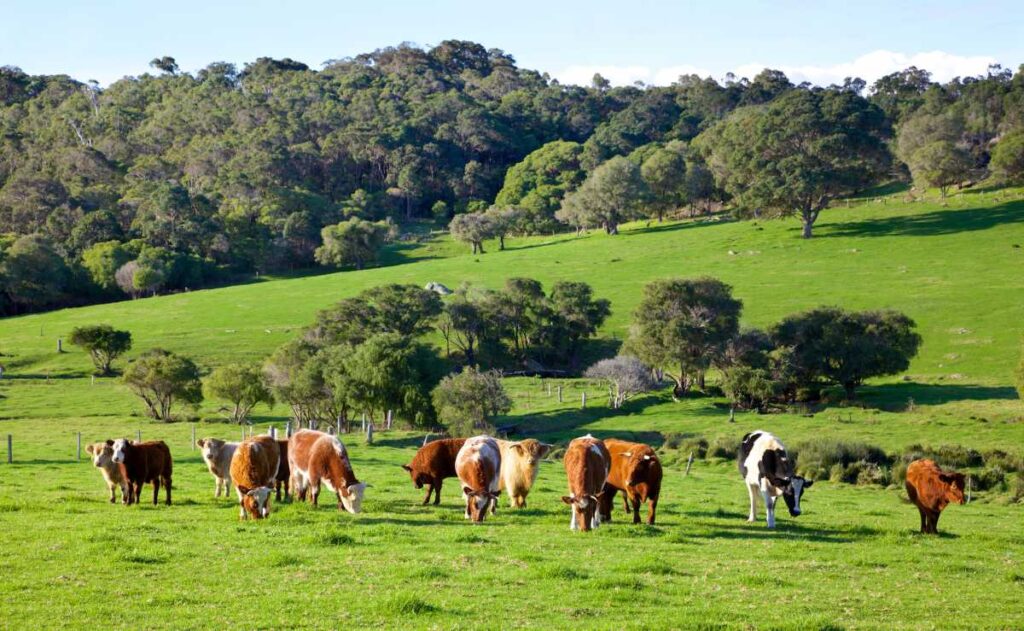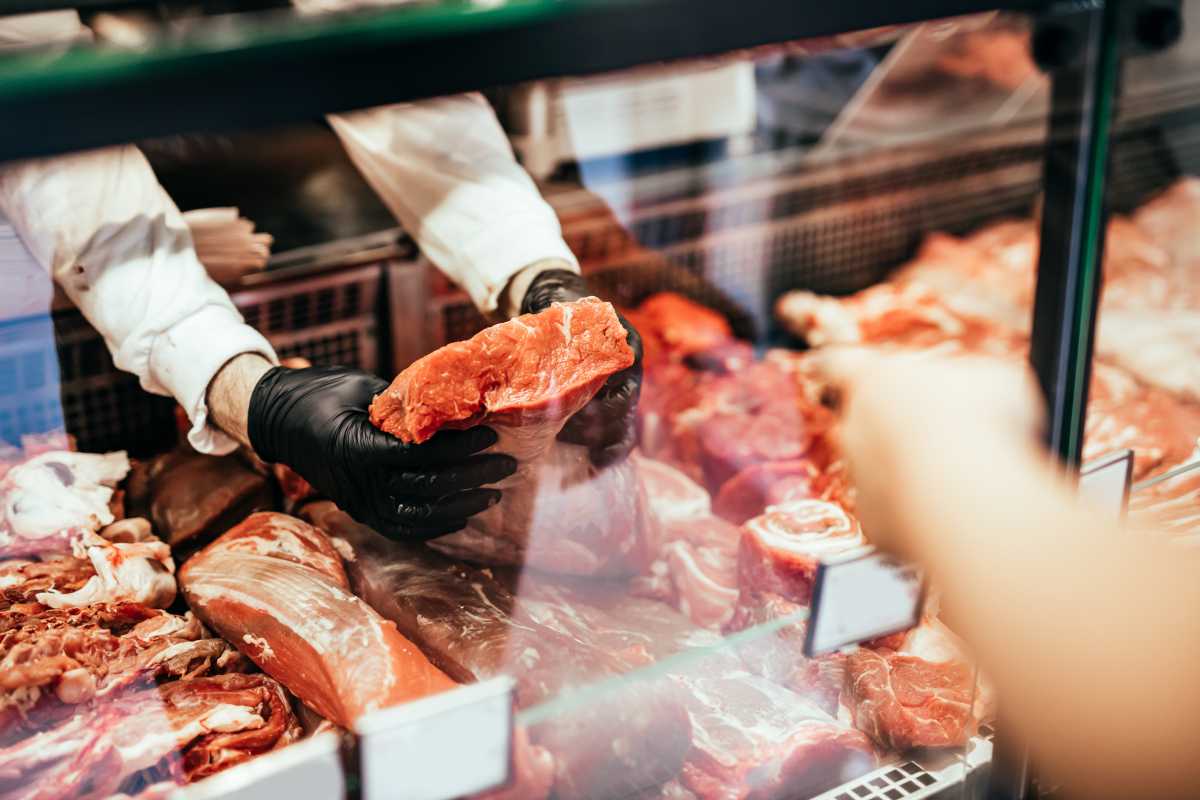
The Difference Between Grass-Fed Beef and Conventional Beef
Australia is a diverse land rich in sunshine, wildlife, and agriculture. The red meat and livestock industry contribute heavily to the national economy, and beef is very much king. Despite its relatively small population, Australia is one of the largest beef producers in the world.
There are two main beef farming methods used in Australia: grass-fed beef production and grain-fed beef production.
Let’s take a look at the beef industry in Australia, review these two farming methods, and look at the benefits of grass-fed beef production for cows and consumers.
The beef industry in Australia
Australia has a huge beef industry that far outweighs the nation’s population. When you include dairy cows, Australia has the 7th largest population of cattle in the world. Australia is also the 7th largest producer of beef and veal in the world, accounting for 4% of global beef production and 16% of world beef trade. Australia has a long history of beef farming, having been one of the top 3 exporters for more than 70 years. Despite recent setbacks, demand for Australian beef continues to grow around the world.
In 2021, the cattle herd was expected to grow 5% to 25.9 million head, which is close to the peak recorded in 2019 before the industry was hit by drought-induced liquidation, trade issues with China, and the global pandemic. According to figures from MLA, Australia’s red meat industry employs around 190,000 people directly and around 245,000 indirectly. Unlike many other beef producers, the vast majority of Australian beef is grass-fed at around 97%. With wide-open spaces, countless grazing pastures, and endless sunshine, Australia can produce an unmatched quantity and quality of grass-fed beef.
What is grass-fed beef?
Also known as pasture-fed beef, grass-fed beef represents most of the Australian market. This style of agriculture is based on traditional farming practices, with cows allowed to graze and feed on natural pastures alone.
Grass-fed cows have the freedom to graze on grass throughout their entire life — moving their bodies, forming groups, and entering into relationships with other cows. They eat based on natural cycles of hunger, the weather, and the wider environment. It’s important to note, however, that grass-fed beef is often processed at large-scale commercial abattoirs, most of which include a short-term industrial feedlot.
This traditional method of farming offers a number of advantages over feedlots, with cows living close to a natural life within the confines of a farm environment. While droughts can lead to a lack of feed in certain conditions, and some animals face stress, natural patterns of grass consumption and cattle movement are known to improve the taste and nutritional profile of the beef produced. In addition, pasture-fed beef is more likely to be free of chemicals and other nasties, with grass-fed cattle often raised without antibiotics and growth hormones.
What is grain-fed beef?
Also known as feedlot beef, grain-fed cattle have spent at least some of their lives in a feedlot. In a typical situation, cows are grain-fed for 60 to 120 days after spending most of their lives in a grass-fed environment. To be classified as grain-fed, cows have to be fed grain for a minimum of 60 days. When grain is given to cows towards the end of their life cycle, farmers can benefit from a more consistent end product. A feedlot is a controlled environment where cows are given a consistent diet based on a number of nutritional grains.
Cows require additional nutrition as they age, and grain-fed farming methods are able to meet this requirement. Common grain feeds include wheat, barley, and sorghum, with other grains also used on occasion.

Grain-fed farming methods are common across much of the world, but the Australian beef industry has been slow to adopt this farming practice. Due to the large size of local pastures and the known quality advantages of grass-fed produce, there is little reason for local beef farmers to get on board. While certain types of beef, such as Wagyu, benefit from grain feed to enhance marbling, most beef consumers in Australia and elsewhere prefer grass-fed products.
Grass-fed vs grain-fed beef taste
The difference between grass-fed beef and grain-fed beef is a matter of taste, sometimes quite literally. While you can’t always tell the difference between products, how cows are fed directly affects the taste profile of the meat produced. The colour of the meat can be distinct between grass-fed and grain-fed products, as is the flavour and consistency. Overall, while grain-fed produce allows for more controlled and consistent production, grass-fed beef offers greater complexity and variety between cuts.
You can often pick grass-fed beef based on the slight yellow hue of the fat content, which is a direct result of the pigments found in natural grass feed. While this may not affect the quality of the beef, it is preferred by many meat eaters. Many consumers prefer grass-fed beef due to its more complex flavour profile, which is a direct result of the varied pastoral diet enjoyed by the cows. Grass-fed beef is often leaner than grain-fed beef, and it can have a different texture. Australian beef is loved across the world for its rich combination of flavours, and for many, this is a direct result of the nation’s grass-fed production methods.
The meat colour of grain-fed beef varies greatly between cattle and produce, with grain-fed cattle often having a brighter colour due to its whiter fat content and extensive marbling. As mentioned above, this is ideal for some types of meat, including Wagyu and similar varieties.
Grain-fed beef also has higher sugar and fat content, which is directly due to the nutritional profile of the grains. The taste of grain-fed beef can also be very different, with more intramuscular fat content leading to a softer and more buttery flavour.
Grass-fed vs grain-fed beef nutrition
Along with differing taste profiles, grass-fed and grain-fed beef can also differ widely in terms of nutrition. While the difference can be minimal with some products, it can also be very significant. Beef mostly consists of protein and fat content, and it’s also loaded with vitamins and minerals. It is full of B12, B3, B6, iron, selenium, and zinc — most of which is bioavailable and ready to fuel your body. Beef is an incredible source of protein, which includes creatine and carnosine for muscle growth and brain function.
Grass-fed produce is often linked with a richer and more complex nutritional profile. For example, it may include additional antioxidant content, which helps to prevent or slow cell damage. It may also feature larger amounts of vitamin E, which can boost immune system function and help to prevent clots in the cardiovascular system. Grass-fed beef often has more balanced fatty acids, including healthy monounsaturated fats, omega-6 polyunsaturated fats, and conjugated linoleic acid (CLA).
Some grass-fed beef products offer up to 5 times the amount of omega-3 fatty acids as grain-fed produce. Omega-3 is hugely beneficial for human health, as it supports eye health, brain health, heart health, and mental wellness. Omega-6 has been shown to help with depression and anxiety, and it supports health at all stages of life. While fat profiles vary greatly between meat products and feed methods, the right fats can help with a wide array of physiological and psychological conditions.
Benefits of grass-fed beef for animals and consumers
Grass-fed beef products offer a range of advantages, both to animals and consumers. For cattle, feeding on grass is a natural way to interact with the environment. They can move their bodies readily to locate and consume food, and eat in natural patterns that align with their hunger and physiological needs. Instead of eating large amounts of food towards the end of their life, they can roam and consume nutrients sporadically as they grow.
For consumers, grass-fed beef offers a range of nutritional and taste benefits, including a better selection of vitamins, minerals, and healthy fatty acids. While it may be less consistent, it can also be richer and have a more complex profile.
How to find a grass-fed beef butcher
If you want to eat grass-fed beef exclusively, you may need to track down a specialist butcher. While most beef in Australia feeds on grass, the amount of grain-fed beef on the market is growing all the time. In some situations, grass-fed cattle are sent to feedlots in their final days. If the number of days is less than 60, it can still be labelled and sold as ‘grass-fed’. Consumer sentiment around this issue is changing all the time, with lots of people wanting to access 100% grass-fed beef produce.

Luckily, there are lots of butchers specialising in true grass-fed beef, including online butcher operations. Online butchers sell a great selection of meat products over the internet, from beef and lamb to pork, chicken, and condiments. With fewer overheads than traditional high street butchers, many of these products are very affordable.
A lot of online butchers specialise in particular types of meat or farming methods, including organic meats and grass-fed beef products. If you want to find a butcher in Australia that offers a great selection of grass-fed beef, we are here to help. Our online butcher delivery service brings A-grade beef and other meat directly to your door, and we do it all with a smile.
For quality meat online at affordable prices, contact the best butcher in Australia today.








